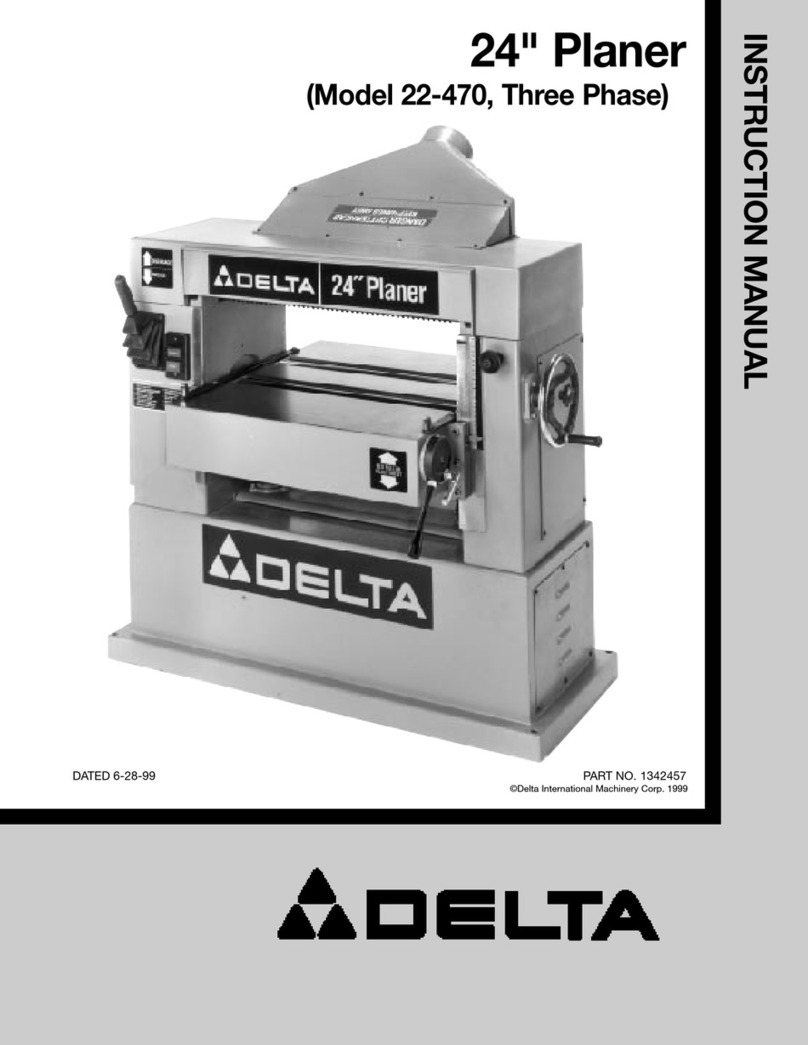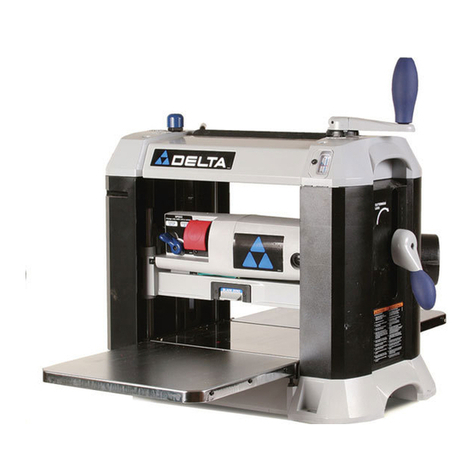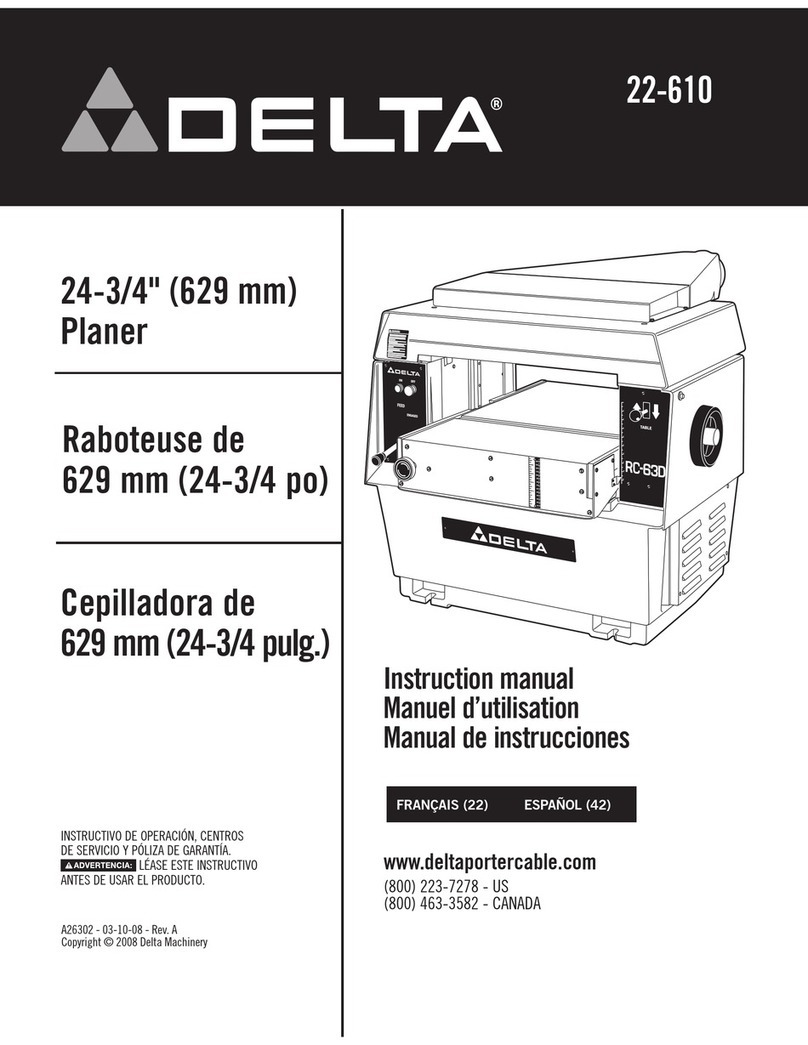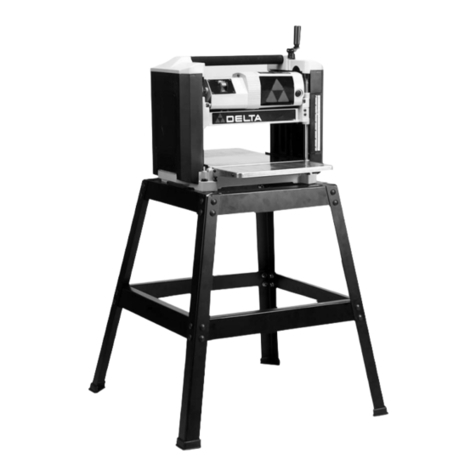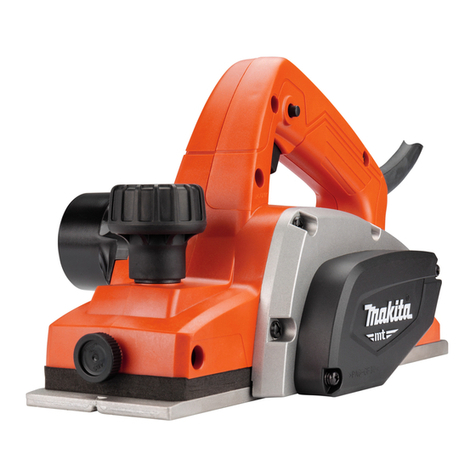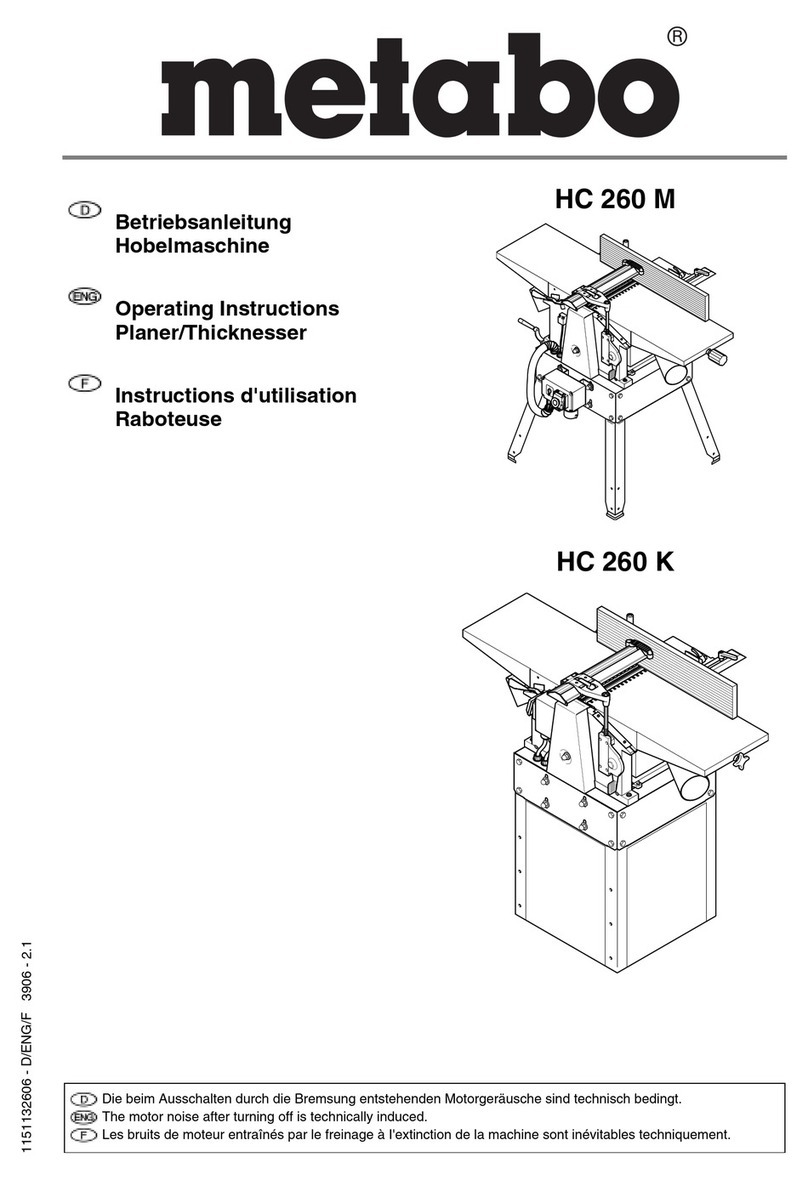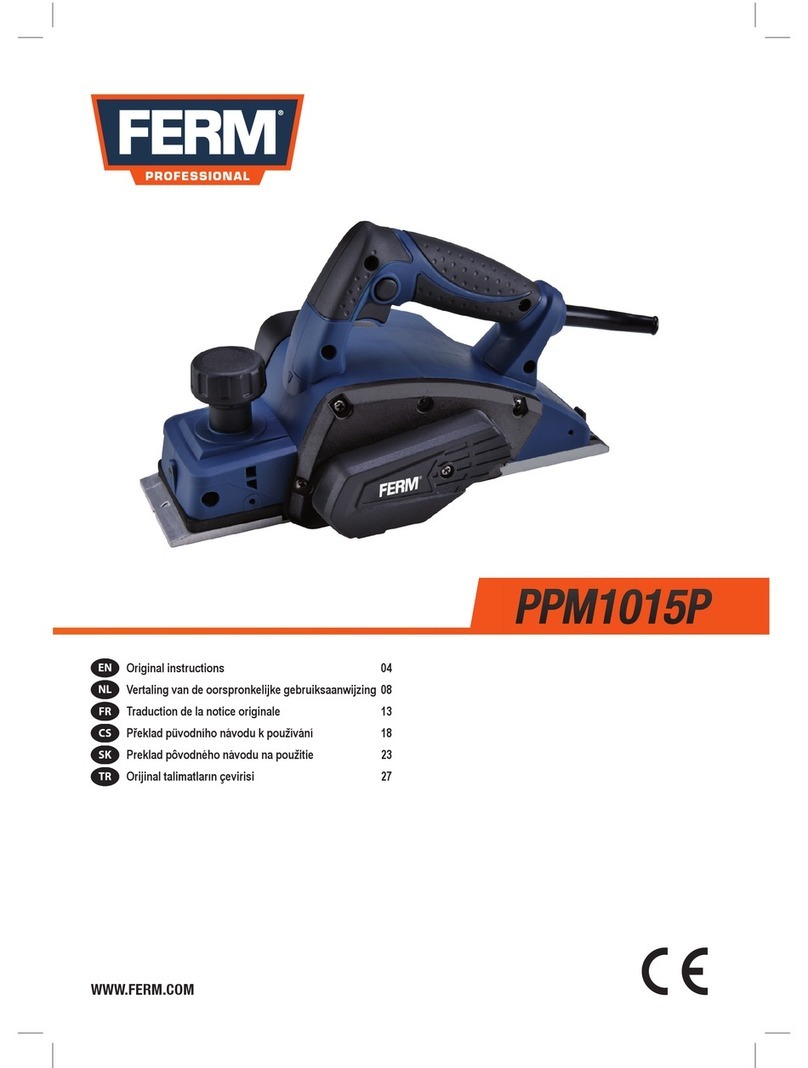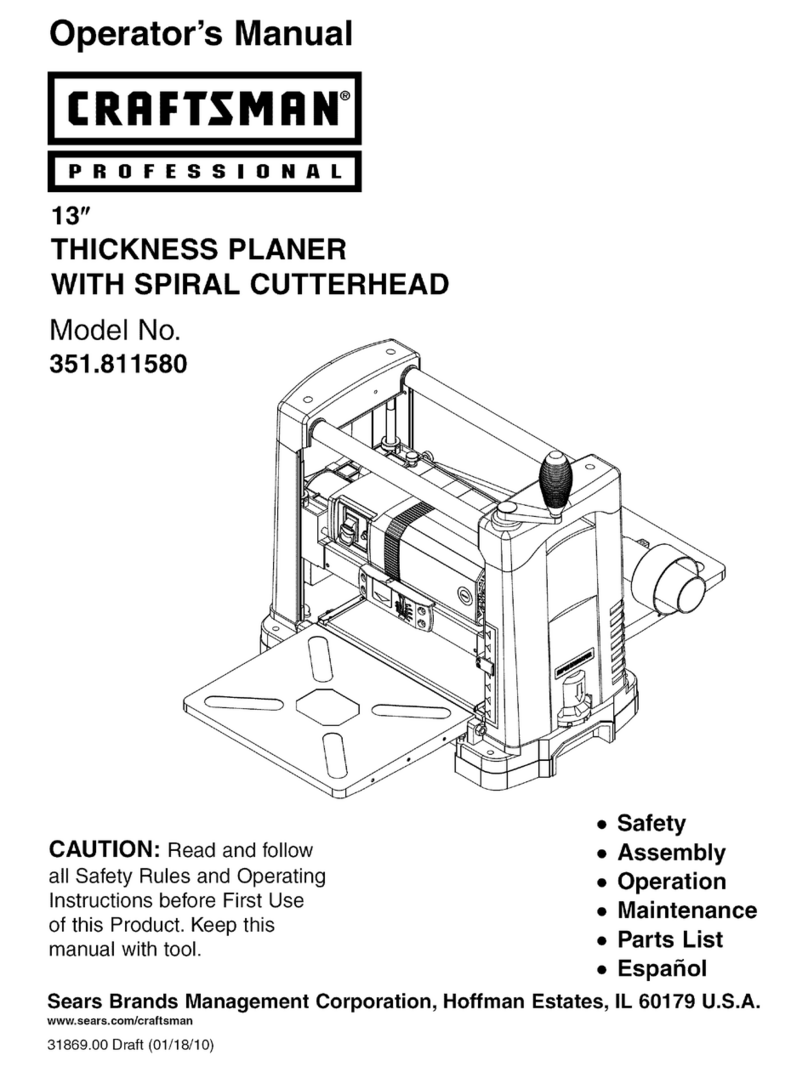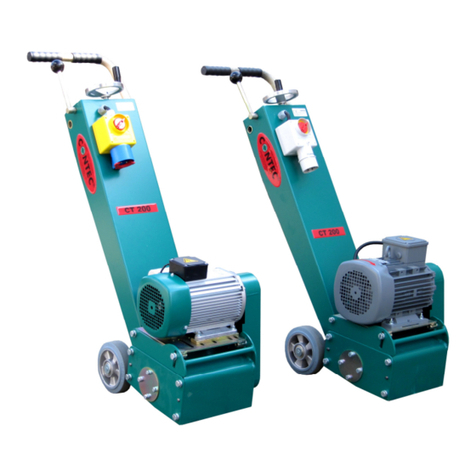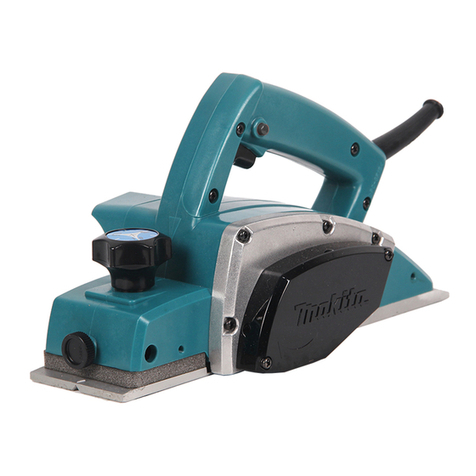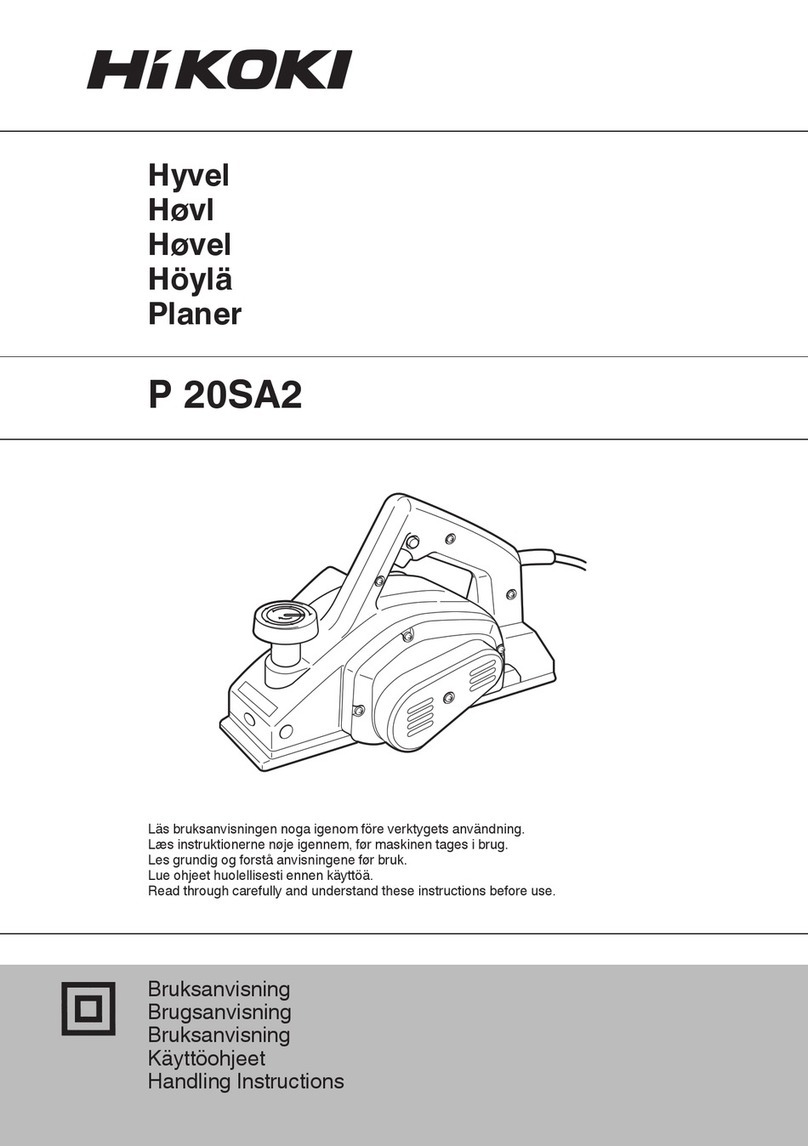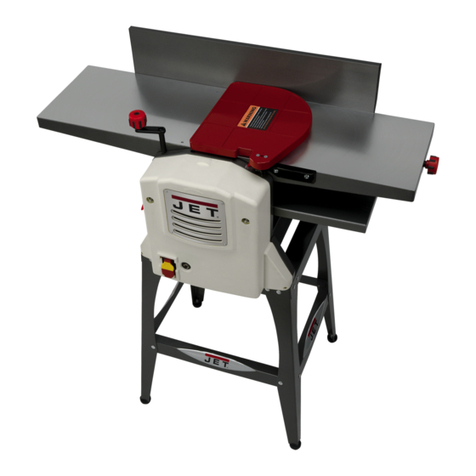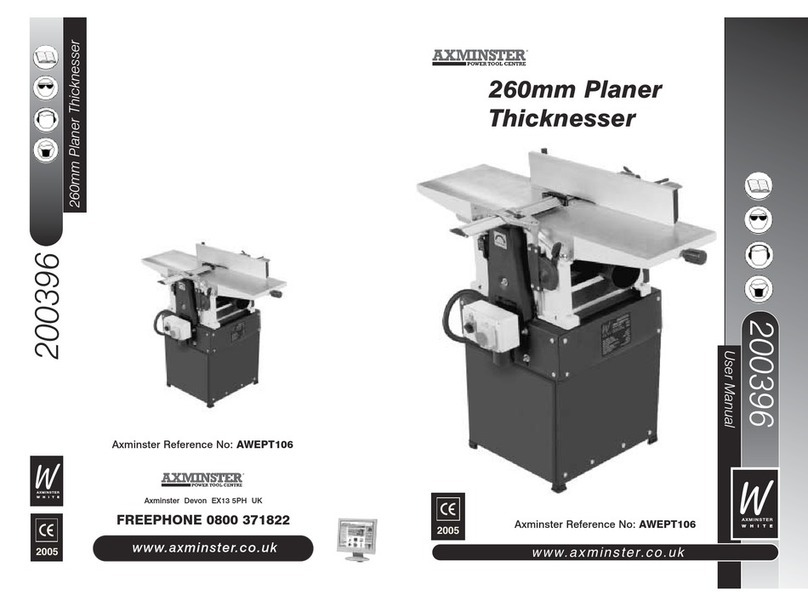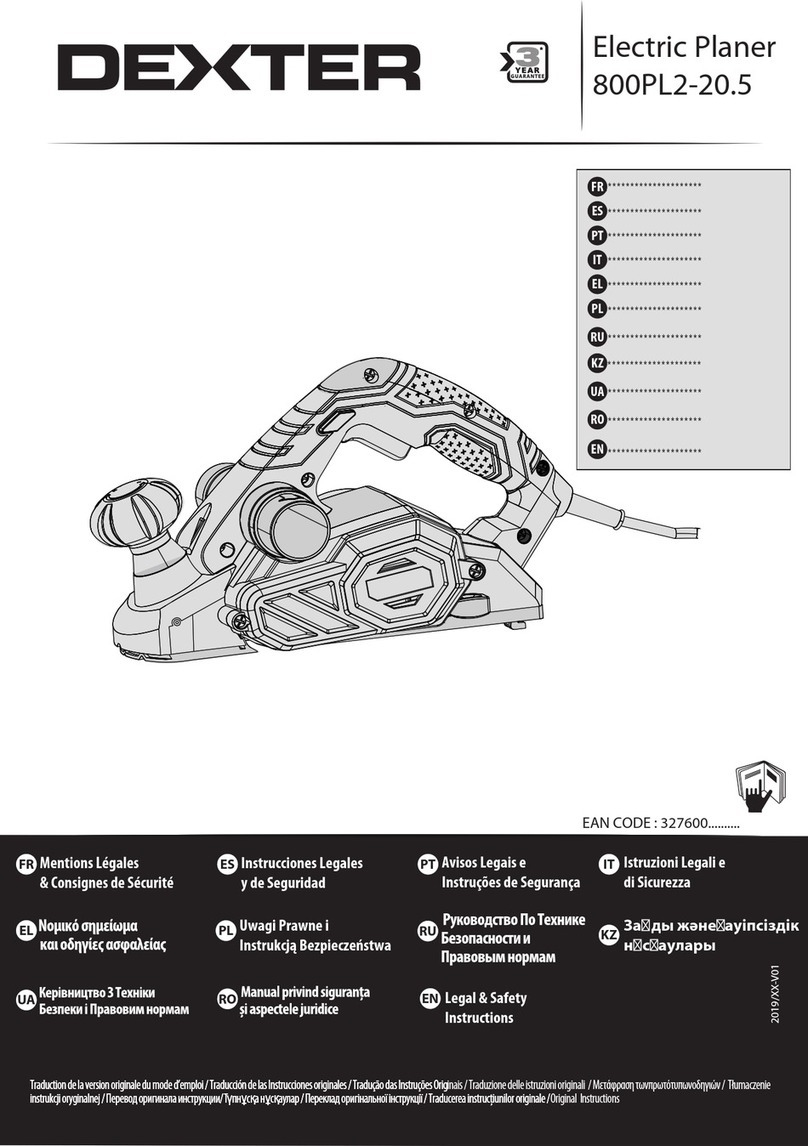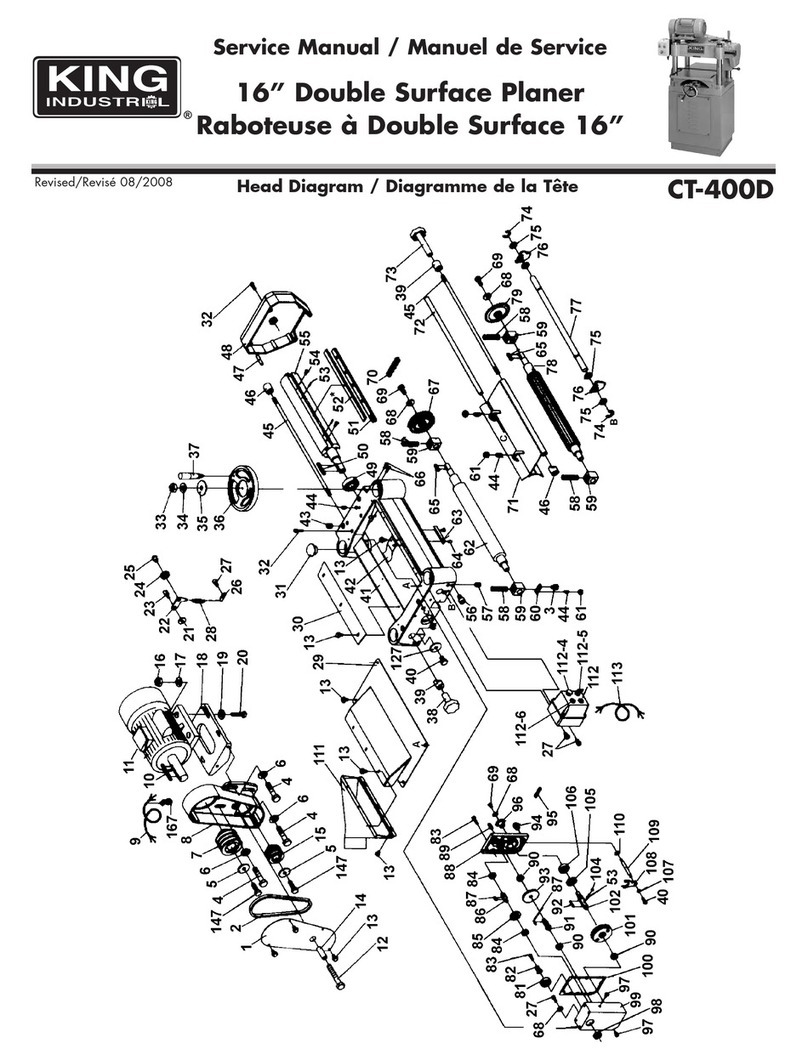Delta RC-33 User manual

Model
RC-33
13"
Planer
Dated
12-1-84
Part
No.
428-06-651-0003
Delta
International
Uacttmery
Corporation.
Inc
INSTRUCTION
MANUAL

WARNING:
FAILURE
TO
FOLLOW
THESE
RULES
MAY
RESULT
IN
SERIOUS
PERSONAL
INJURY.
IMPORTANT
As
with
all
machinery
there
are
certain
hazards
involved
with
operation
and
use
of
the
machine.
Using
the
machine
with
respect
and
caution
will
considerably
lessen
the
possibility
of
personal
injury.
However,
if
normal
safety
precautions
are
overlooked
or
ignored,
personal
injury
to
the
operator
may
result.
This
machine
was
designed
for
certain
applications
only.
Delta
Machinery
strongly
recommends
that
this
machine
NOT
be
modified
and/or
used
for
any
application
other
than
for
which
it
was
designed.
If
you
have
any
questions
relative
to
its
application
DO
NOT
use
the
machine
until
you
have
written
Delta
Machinery
and
we
have
advised
you.
DELTA
INTERNATIONAL
MACHINERY
CORP.
MANAGER
OF
TECHNICAL
SERVICES
246
ALPHA
DRIVE
PITTSBURGH.
PENNSYLVANIA
15238
SAFETY
RULES
FOR
ALL
TOOLS
1.
FOR
YOUR
OWN
SAFETY.
READ
INSTRUCTION
MANUAL
BEFORE
OPERATING
THE
TOOL.
Learn
the
tool's
application
and
limitations
as
well
as
the
specific
hazards
peculiar
to
it.
2.
KEEP
GUARDS
IN
PLACE
and
in
v/orking
order.
3.
GROUND
ALL
TOOLS.
If
tool
is
equipped
with
three-
prong
plug,
it
should
be
plugged
into
a
three-hole
electrical
receptacle.
If
an
adapter
is
used
to
accomodate
a
two-prong
receptacle,
the
adapter
lug
must
be
attached
to
a
known
ground-
Never
remove
the
third
prong.
4.
REMOVE
ADJUSTING
KEYS
AND
WRENCHES.
Form
habit
of
checking
to
see
that
keys
and
adj'usting
wrenches
are
removed
from
tool
before
turning
it
"on".
5.
KEEP
WORK
AREA
CLEAN.
Cluttered
areas
and
benches
invite
accidents.
6.
DON'T
USE
IN
DANGEROUS
ENVIRONMENT.
Don't
use
power
tools
in
damp
or
wet
locations,
or
expose
them
to
rain.
Keep
work
area
well
lighted.
7.
KEEP
CHILDREN
AND
VISITORS
AWAY,
All
children
and
visitors
should
be
kept
a
safe
distance
from
work
area.
8.
MAKE
WORKSHOP
CHILDPROOF
•
with
padlocks,
master
switches,
or
by
removing
starter
keys.
9.
DON'T
FORCE
TOOL.
It
will
do
the
job
better
and
be
safer
at
the
rate
for
which
it
was
designed.
10.
USE
RIGHT
TOOL.
Don't
force
tool
or
attachment
to
do
a
job
for
which
it
was
not
designed.
11.
WEAR
PROPER
APPAREL.
No
loose
clothing,
gloves,
neckties,
rings,
bracelets,
or
other
jewelry
to
get
caught
in
moving
parts.
Nonslip
foot
wear
is
recommended.
Wear
protective
hair
covering
to
contain
long
hair.
12.
ALWAYS
USE
SAFETY
GLASSES.
Also
use
face
or
dust
mask
if
cutting
operations
is
dusty.
Everyday
eyeglasses
only
have
impact
resistant
lenses;
they
are
NOT
safety
glasses.
13.
SECURE
WORK.
Use
clamps
or
a
vise
to
hold
work
when
practical.
It's
safer
than
using
your
hand
and
frees
both
hands
to
operate
tool.
14.
DON'T
OVERREACH.
Keep
proper
footing
and
balance
at
all
times.
15.
MAINTAIN
TOOLS
IN
TOP
CONDITION.
Keep
tools
sharp
and
clean
for
best
and
safest
performance.
Follow
instructions
for
lubricating
and
changing
accessories.
16.
DISCONNECT
TOOLS
before
servicing
and
when
chang¬
ing
accessories
such
as
blades,
bits,
cutters,
etc.
17.
USE
RECOMMENDED
ACCESSORIES.
Consult
the
owner's
manual
for
recommended
accessories.
The
use
of
improper
accessories
may
cause
hazards.
18.
AVOID
ACCIDENTAL
STARTING.
Make
sure
switch
is
in
"OFF”
position
before
plugging
in
power
cord.
19.
NEVER
STAND
ON
TOOL.
Serious
injury
could
occur
if
the
tool
is
tipped
or
if
the
cutting
tool
is
accidentally
contacted.
20.
CHECK
DAMAGED
PARTS.
Before
further
use
of
the
tool,
a
guard
or
other
part
that
is
damaged
should
be
carefully
checked
to
ensure
that
it
will
operate
properly
and
perform
its
intended
function
-
check
for
alignment
of
moving
parts,
binding
of
moving
parts,
breakage
of
parts,
mounting,
and
any
other
conditions
that
may
affect
its
operation.
A
guard
or
other
part
that
is
damaged
should
be
properly
repaired
or
replaced.
21.
DIRECTION
OF
FEED.
Feed
work
into
a
blade
or
cutter
against
the
direction
of
rotation
of
the
blade
or
cutter
only.
22.
NEVER
LEAVE
TOOL
RUNNING
UNATTENDED,
TURN
POWER
OFF.
Don't
leave
tool
until
it
comes
to
a
complete
stop.
23.
DRUGS,
ALCOHOL,
MEDICATION.
Do
not
operate
tool
while
under
the
influence
of
drugs,
alcohol
or
any
medi¬
cation.
24.
MAKESURETOOLIS
DISCONNECTED
FROM
POWER
SUPPLY
while
motor
is
being
mounted,
connected
or
recon¬
nected.

UNPACKING
Remove
the
wooden
crate
from
around
the
machine.
Remove
four
screws
{A)
Fig.
1,
and
shipping
plates
(B).
If
you
purchased
the
three
phase
machine,
your
planer
is
^
shipped
complete
with
motor,
motor
pulley
and
belts
assembled
to
the
machine.
The
switch
in
wired
to
the
motor
and
it
is
necessary
to
mount
the
switch
to
the
side
of
the
planer,
as
explained
later
on
in
this
manual.
If
you
purchased
the
single
phase
machine,
the
belt
guard,
motor
plate
and
belts
are
not
assembled
to
the
machine.
The
motor
for
the
single
phase
machine
is
shipped
in
a
separate
carton
and
the
belt
guard,
motor
plate,
motor,
motor
pulley
and
belts
must
be
assembled
to
the
planer
as
explained
later
on
in
this
manual.
CLEANING
Fig.
1
Remove
the
protective
coating
from
the
table,
bed
rolls,
feed
rolls,
cutterhead
and
loose
items
packed
with
the
machine,
including
lifting
handles
and
motor
pulley.
This
coating
may
be
removed
with
a
soft
cloth
moistened
with
kerosene
{do
not
use
acetone,
gasoline,
or
lacquer
thinner
for
this
purpose),
CARE
MUST
BE
TAKEN
WHEN
CLEANING
THE
CUTTERHEAD
AS
THE
KNIVES
ARE
IN
THE
CUTTERHEAD
AND
THESE
KNIVES
ARE
VERY
SHARP.
After
cleaning
table,
cover
table
surface
with
a
good
quality
paste
wax.
ASSEMBLING
LIFTING
HANDLES
Your
machine
Is
supplied
with
four
lifting
handles
that
are
to
be
assembled
to
the
front
and
rear
of
the
planer
table.
The
two
front
lifting
handles
are
shown
at
(A)
Fig.
2.
To
assemble
the
lifting
handies
to
your
planer,
proceed
as
follows.
1.
Tilt
the
machine
on
its
back.
2.
Remove
retainer
(B)
Fig.
3,
from
end
of
lifting
handle
(C).
3.
Insert
groove
end
of
lifting
handle
(C)
through
hole
in
table
casting
and
through
hole
in
boss
(D),
as
shown
in
Fig.
3
4.
Reassemble
retainer
(B)
Fig.
3,
to
groove
in
end
of
lift¬
ing
handle.
5.
A
ssemble
remaining
three
lifting
handles
to
planer
in
the
same
manner.
Fig.
4
illustrates
two
lifting
handles
(A)
as¬
sembled
to
one
end
of
the
machine.

Fig.
5
ASSEMBLING
ACCESSORY
50-31B
STAND
If
yoj
purchased
the
accessory
50*315
Stand
for
use
with
your
planer,
assemble
the
stand
as
follows:
1.
Assemble
the
stand
as
shown
in
Fig.
5,
using
the
24
screws
and
nuts
supplied.
Only
tighten
the
screws
and
nuts
finger
tight
at
this
time.
2.
Fig.
6
illustrates
the
proper
relationdnip
of
the
screws
and
nuts
to
the
stand.
Place
the
stand
on
a
level
surface
and
tighten
tiie
screws
and
nuts
in
the
following
order.
First
the
eight
lower
tie
bar
screws
and
nuts
(A),
second
the
eight
upper
tie
bar
screws
and
nuts
(B)
and
third
the
eight
top
shelf
screws
and
nuts
(C)
Fig.
6.
4-
3/8"
DIa.
Holes
I
©-
18.50"
©
-®-
|--17.00"--|
FRONT
Fig.
7
ASSEMBLING
PLANER
TO
ACCESSORY
50-315
STAND
OR
BENCH
If
you
are
assembling
the
planer
to
the
accessory
50-315
Stand
or
a
bench
of
suitable
height,
it
will
be
necessary
to
drill
four
holes
in
either
stand
or
bench.
Refer
to
Fig.
7,
for
the
center
to
center
distance
and
size
of
the
four
holes
to
be
drilled.
When
lifting
die
planer
to
position
it
on
the
stand
or
bench,
the
machine
must
be
lifted
by
the
lifting
handles.
Fig.
8
illustrates
the
machine
being
lifted
by
the
lifting
handles
using
a
sling.
4

ASSEMBLING
HEAD
RAISING
AND
LOWERING
HANDLE
Using
a
screw
driver
(A),
assemble
the
head
raising
and
lower¬
ing
handle
(B)
to
the
handle
bracket
(C)
as
shown
in
Fig.
9.
ASSEMBLING
SWITCH
TO
THREE
PHASE
MACHINE
If
you
purchased
the
three
phase
machine,
it
is
necessary
to
assemble
the
switch
and
switch
plate
assembly
(A)
to
the
front
left
hand
side
of
the
planer,
as
shown
in
Fig.
10,
using
the
two
screws
(B),
ASSEMBLING
BELT
GUARD,
MOTOR
PLATE,
MOTOR
PULLEY,
MOTOR
AND
BELTS
TO
SINGLE
PHASE
MACHINE.
1,
Remove
cover
from
side
of
belt
guard
and
assemble
belt
guard
(A)
to
the
side
of
the
planer
using
screw
and
washer
(B)
and
long
screw
(C)
and
spacer
(D),
as
shown
in
Fig.
11.
The
belt
guard
(A)
should
be
as
far
to
the
left
as
it
will
travel
in
slot
(E)
as
shown
in
Fig.
11,
for
correct
operating
position.
5
Fig.
11

Fig.
12
2.
Assemble
motor
plate
(F)
to
belt
guard
(A)
using
two
screws
and
washers
{G),
as
shown
in
Fig.
12.
3.
Assemble
motor
pulley
(H)
to
motor
shaft,
as
shown
in
Fig.
13.
Make
sure
key
is
inserted
into
keyway
of
motor
shaft
and
motor
pulley
and
tighten
two
screws
in
motor
pulley
using
alien
wrench
(J}.
4.
Place
motor
(K)
on
motor
plate
(F),
as
shown
in
Fig,
14,
with
motor
pulley
through
hole
in
belt
guard.
Fasten
motor
(K)
to
motor
plate
(F)
using
the
four
sets
of
motor
mounting
bolts,
washer
and
nuts
(L).
Do
not
completely
tighten
motor
mounting
nuts
and
bolts
at
this
point.
5.
Using
a
straight
edge,
align
motor
pulley
(Hi
to
cutter-
head
pulley
(M),
as
shown
in
Fig.
15,
by
sliding
motor
on
motor
plate.
Then
tighten
motor
mounting
hardware.
6.
Loosen
two
screws
(G)
so
that
motor
plate
will
move
down
and
assemble
the
three
belts
(0)
to
motor
pulley
(H)
and
cutterhead
pulley
(M),
as
shown
in
Fig.
16.
7.
Adjust
belt
tension
by
referring
to
the
section
on
ADJUSTING
BELT
TENSION
later
in
this
manual.
8.
Assemble
cover
to
side
of
belt
guard.
9.
The
motor
cord
should
be
placed
through
the
clamp
(P)
and
the
clamp
(P)
should
be
fastened
to
the
threaded
hole
located
on
the
left
front
top
of
machine
using
screw
{R),
as
shown
in
Fig.
16A.
Fig.
15
Fig.
16
6

ASSEMBLING
FEED
ROLL
SHIFTER
MECHANISM
1.
Remove
screw
(A)
Fig.
17,
and
gear
box
cover
(B).
Fig.
17
2,
Loosen
set
screw
(C)
Fig.
18,
and
remove
collar
(D).
10mm
LOCKW
ASHER
BALL
SPRING
swifter
BRACKET
RUBBER
COVER
LEVER
Fig.
19
3.
Fig.
19,
shows
the
shifter
mechanism
components
which
are
shipped
unassembled
with
the
planer.
4.
Assemble
the
shifter
bracket
(E)
Fig.
20,
spring
(F)
and
ball
(G)
as
shown.
NOTE;
The
spring
and
ball
can
be
depressed
using
a
small
screwdriver
blade.
Fig.
20
5.
Fig.
21,
illustrates
the
shifter
bracket
(E)
in
the
assembled
position.
Fig.
21
7

6.
Reassemble
collar
(D)
Figs.
22
and
23
7.
Tighten
set
screw
(C)
Fig,
23,
into
countersunk
hole
(H)
Fig.
22,
8.
Assemble
lever
(J)
Fig,
24,
to
gear
box
cover
(B)
as
shown,
using
the
10mm
lockwasher
(K)
and
M10
hex
nut
(L)
supplied.
9.
Assemble
rubber
cover
(M)
Fig,
25,
over
shifter
bracket
and
then
assemble
gear
box
cover
with
lever
as
shown.
Lever
should
engage
shifter
bracket.
10.
Replace
screw
(A)
Fig.
25,
and
tighten

ELECTRICAL
CONNECTIONS
Before
connecting
your
machine
to
an
electrical
power
system,
make
sure
the
motor
rating
agrees
with
the
electrical
system
it
is
to
be
connected
to.
SINGLE
PHASE
MACHINE
The
motor
supplied
with
the
Single
Phase
Planer
is
wired
for
230
Volts,
Single
Phase
Operation
and
is
supplied
with
a
power
cord
equipped
with
a
plug
that
has
two
flat,
current-
carrying
prongs
in
tandem
and
one
round
or
"U"
shaped
longer
ground
prong,
as
shown
in
Fig.
26.
This
is
used
only
with
the
proper
mating
3-conductor
grounding
type
recep¬
tacle,
as
shown
in
Fig.
26.
When
the
three-prong
plug
on
your
planer
Is
plugged
into
a
grounded,
3-conductor
receptacle,
as
shown
in
Fig.
26,
the
long
ground
prong
on
the
plug
contacts
first
so
the
machine
is
properly
grounded
before
electricity
reaches
it.
THREE
PHASE
MACHINE
The
motor
supplied
with
the
Three
Phase
Planer
is
wired
for
220
Volts,
Three
Phase
Operation.
If
you
desire
to
operate
your
planer
at
440
Volts,
Three
Phase
Operation
refer
to
the
instructions
under
CHANGING
FROM
220
TO
440
VOLTS,
THREE
PHASE
OPERATION.
To
connect
power
to
your
machine,
proceed
as
follows
for
either
220
or
440
Volts,
Three
Phase
Operation:
1.
R
emove
two
screws,
one
of
whic^i
is
shown
at
(A)
Fig.
27,
and
remove
switch
cover
(B).
Fig.
27
2.
Insert
power
line
(C)
Fig.
28.
through
entrance
hole
{
□
}
on
bottom
of
switch
box,
and
up
in
back
of
starter
and
overload
(E).
Connect
the
three
power
lines
to
terminals
(F)
and
the
green
ground
wire
to
the
ground
terminal
(G)
Fig.
28.
IMPORTANT:
If
after
the
machine
is
in
operation,
the
cutterhead
revolves
in
the
wrong
rotation,
simply
Inter¬
change
any
two
of
the
three
power
lines
that
are
connected
to
terminals
(F)
Fig.
28.
3.
Replace
switch
cover.
Fig.
28
9

CHANGING
FROM
220
TO
440
VOLTS,
THREE
PHASE
OPERATION
If
you
desire
to
change
the
voltage
on
your
Three
Phase
Machine
from
220
Volts
to
440
Volts,
proceed
as
follows:
1.
D
isconnect
the
machine
from
the
power
source.
2.
R
emove
two
screws,
one
of
which
is
shown
at
(A)
Fig.
29,
and
remove
switch
cover
(B).
3.
L
oosen
screw
(C)
Fig.
30,
and
pull
out
starter
and
over¬
load
block
(D).
4.
F
ig.
31,
illustrates
the
starter
and
overload
block
(D)
removed
from
the
switch
box.
Remove
two
screws
(E)
Fig.
31
and
hold
plate
(F)
so
it
will
not
spring
out.
Carefully
remove
plate
IF)
Fig.
31.
Fig.
30
Fig.
31
5.
Remove
yoke
(G)
Fig.
32.
10
Fig.
32

6.
R
emove
plate
(H)
and
two
springs,
one
of
which
is
shown
at
(J)
Fig.
33.
7.
P
ull
out,
disconnect
leads,
and
remove
220
Volt
coil
(K)
Fig,34.
8.
Replace
with
440
Volt
coil
(available
from
Rockwell
as
part
no.
438-01-003-0434),
and
reassemble
in
the
reverse
order.
9.
For
440
Volt
operation,
the
amp
setting
dial
(L)
Fig.
35,
should
be
set
at
5.0.
For
220
Volt
operation,
the
amp
setting
dial
(L)
should
be
set
at
9.0.
10.
R
emove
motor
junction
box
cover
to
expose
motor
wires
and
reconnect
motor
wires
for
440
Volt
operation.
Fig.
36
illustrates
motor
wire
connections
for
220
Volts
and
440
Volts.
Fig.
34
Fig.
35
11
Fig.
36

OPERATING
CONTROLS
SWITCH
The
ON-OFF
switch
for
Single
Phase
machines
is
located
on
the
front
portion
of
the
motor,
as
shown
at
(A)
Fig,
37.
Fig.
37
The
ON-OFF
switch
for
Three
Phase
machines
is
located
on
the
switch
box,
as
shown
at
(B)
Fig.
38.
Fig.
38
OVERLOAD
PROTECTION
Your
planer
is
provided
with
overioad
protection
which
will
shut
off
the
motor
if
the
planer
is
overloaded
or
if
line
voltage
falls
below
safe
levels.
If
the
motor
shuts
off
due
to
overload¬
ing
or
low
voltage,
proceed
as
follows
for
Single
and
Three
Phase
machines:
On
Single
Phase
machines,
shut
off
switch
(A)
Fig.
39,
let
the
motor
cool
for
approximately
five
minutes
and
push
the
reset
button
(B|,
which
will
reset
the
overload
device.
The
motor
can
then
be
turned
on
again
in
itie
usual
manner.
Fig.
39
On
Three
Phase
machines,
let
the
motor
cool
for
approximately
five
minutes.
The
overload
block
supplied
with
this
planer
will
automatically
reset
itself
and
the
machine
can
be
started
again
by
pushing
the
start
button,
If
the
machine,
either
single
or
three
phase,
continually
shuts
off
due
to
overloading,
the
cause
of
overloading
must
be
corrected.
If
this
happens,
it
is
recommended
you
obtain
advice
from
a
qualified
electrician.
12

DEPTH
OF
CUT
ADJUSTMENT
The
depth
of
cut
on
your
planer
is
controlled
by
raising
or
lowering
the
head
assembly
(A)
Fig.
40,
which
contains
the
cutterhead
and
feed
rolls.
The
head
assembly
(A)
raises
and
lowers
on
four
precision
ground
steel
columns.
To
adjust
for
depth
of
cut
simply
loosen
the
two
head
assembly
lock
knobs
(C)
and
turn
the
elevating
handle
(D)
Fig,
40.
After
the
desired
depth
of
cut
is
obtained,
lock
the
two
head
assembly
lock
knobs
(C)
Fig.
40.
A
combination
inch/metric
scale
(B)
Fig.
40,
is
conveniently
located
on
the
right
front
column
for
easy
reading.
The
maximum
depth
of
cut
on
full
width
planing
with
the
3
horsepower.
Three
Phase
motor
is
3/16"
{4.763
m
m).
The
maximum
depth
of
cut
on
full
width
planing
with
a
2
Horsepower,
Single
Phase
motor
is
1/8"
(3.175
m
m).
A
limiter
(A)
Fig.
41,
is
provided
on
single
phase
machines
to
limit
the
depth
of
cut
on
full
width
planing
from
3/16"
to
1/8".
Fig
42
ANTI-KICKBACK
FINGERS
Anti-kickback
fingers
(A)
Fig.
42.
are
provided
on
your
planer
to
prevent
kickback.
These
fingers
operate
by
gravity
and
it
is
necessary
to
inspect
them
occasionally
to
make
sure
they
are
free
of
gum
and
pitch
so
that
they
move
independently
and
operate
correctly.
FEED
ROLL
SPEED
CONTROL
Your
machine
is
equipped
with
a
spiral,
serrated
infeed
roll
(B)
and
a
solid
steel
outfeed
roll
(C|
Fig.
42.
When
the
feed
rolls
are
engaged,
they
turn
and
feed
the
stock.
The
feed
rolls
slow
automatically
when
the
machine
is
under
^
heavy
load
for
best
planing
under
all
conditions.
The
feed
rolls
are
driven
by
a
chain
and
sproket
drive
(D)
Fig.
43,
which
takes
power
directly
from
the
cutterhead
through
the
oil
bath
gear
box
(E).
To
engage
the
feed
rolls,
pull
out
lever
(F)
Fig.
44.
To
dis¬
engage
the
feed
rolls
push
in
on
lever
(F),
^!
Fig.
40
Wm
Fig.
41
Fig.
44
13

ADJUSTMENTS
Although
your
planer
was
carefully
adjusted
at
the
factory,
it
should
be
checked
before
being
put
into
operation.
Any
inaccuracies
due
to
rough
handling
in
transit
can
easily
be
corrected
by
following
these
directions.
In
order
to
check
the
adjustments
you
will
need
a
straight
edge,
feeler
gage
and
a
homemade
gage
block
made
of
hard¬
wood.
This
gage
block
can
be
made
by
following
the
dimen¬
sions
shown
in
Fig.
45,
WHEN
CHECKING
ADJUSTMENTS,
ALWAYS
MAKE
SURE
THE
PLANER
IS
DISCONNECTED
FROM
THE
POWER
SOURCE.
ADJUSTING
BELT
TENSION
To
adjust
the
belt
tension
on
your
machine,
proceed
as
follows:
1.
Disconnect
machine
from
the
power
source.
2.
Remove
belt
and
pulley
cover
from
the
machine.
3.
.
Place
a
2
X
4
(A)
Fig.
46,
underneath
the
motor
plate,
as
shown,
4.
Loosen
two
bolts
(B)
Fig,
46,
and
pry
up
on
the
motor
plate
until
correct
belt
tension
is
obtained.
Correct
tension
is
obtained
when
there
is
approximately
1/4”
deflection
in
the
center
span
of
the
belts
using
light
finger
pressure.
Then
tighten
two
bolts
(B)
Fig.
46,
and
replace
side
cover.
Fig.
46
CHECKING,
ADJUSTING
AND
REPLACING
KNIVES
When
checking,
adjusting
or
replacing
the
cutterhead
knives,
proceed
as
follows:
1.
Disconnect
the
machine
from
the
power
source.
2.
Remove
four
screws,
three
of
which
are
shown
at
(A)
Fig.
47,
and
remove
top
cover
(B).
3.
Loosen
two
screws
(C)
Fig.
48,
and
tilt
motor
assembly
(D)
to
the
front
as
shown.
4.
To
check
and
adjust
knives,
proceed
as
follows:
A.
Check
all
three
knives
for
proper
setting
using
the
knife
gage
as
shown
in
Fig.
49.
When
the
gage
(A)
is
placed
on
the
cutterhead
as
shown,
the
knife
should
just
contact
the
bottom
of
both
set
screws
[B)
Fig.
49.
Fig.
47
14

B.
If
any
of
the
knives
require
an
adjustment,
slightly
loosen
the
knife
locking
bar
of
each
of
the
three
knives
by
turning
the
locking
screws
(D)
Fig,
49,
into
the
locking
bar
just
enough
to
relieve
stress
in
the
cutterhead
but
not
disturb
the
setting
of
the
three
knives.
C.
To
adjust
the
knife
that
must
be
reset,
loosen
all
four
locking
screws
(D)
Fig.
49,
by
turning
them
into
the
locking
bar.
As
the
knife
locking
bar
becomes
loose,
lifter
springs
under
the
knife
will
raise
the
knife
until
it
contacts
the
bottom
of
both
set
screws
(B)
of
the
gage.
Then
snug
up
the
knife
locking
bar
by
lightly
backing
out
the
four
locking
screws
(D)
against
the
knife
slot.
IMPORTANT:
AT
THIS
TIME,
ONLY
TIGHTEN
THE
KNIFE
INTO
THE
SLOT
ENOUGH
TO
HOLD
IT
IN
POSITION.
D.
If
additional
knives
must
be
reset,
repeat
Step
C.
E.
After
all
three
knives
are
set
with
screws
just
snug,
back
out
and
tighten
the
four
locking
screws
(D)
Fig.
49,
against
the
slot,
starting
with
the
end
screws
first,
then
the
center
screws
until
the
knife
is
securely
held
in
the
cutterhead.
Tighten
the
remaining
two
knives
in
the
same
manner.
5.
If
the
knives
are
removed
for
sharpening,
care
must
be
exercised
in
replacing
and
resetting
them,
as
follows:
A.
To
remove
each
knife,
loosen
the
knife
locking
bar,
by
turning
the
four
locking
screws
(D)
Fig.
49,
into
the
knife
locking
bar
and
remove
the
locking
bar,
knife
and
springs
located
under
the
knife.
B.
Remove
the
remaining
two
knives
in
the
same
manner,
C.
Thoroughly
clean
the
knife
slots,
knife
bars,
springs
and
screws.
Check
the
screws.
If
the
threads
appear
worn
or
stripped
or
if
the
heads
are
becoming
rounded
replace
them.
D.
Inspect
the
cutting
edge
of
the
knives
for
nicks
or
wire
edge.
Hone
the
knives
slightly
using
a
stone
or
if
the
knives
are
to
be
sharpened,
maintain
a
cutting
angle
of
35
degrees.
E.
Insert
springs,
knives
and
knife
locking
bars
into
all
three
slots
in
the
cutterhead.
Back
out
locking
screws
(D)
Fig.
49,
just
enough
to
hold
all
three
knives
in
the
cutterhead.
F.
Adjust
all
three
knives
as
explained
in
Step
4,
above.
Fig.
49
15

ADJUSTING
FEED
ROLL
SPRING
TENSION
The
infeed
roll
(A)
and
outfeed
roll
(B)
Fig.
50,
are
those
parts
of
yoLJr
planer
that
feed
the
stock
while
it
is
being
planed.
The
feed
rolls
(A)
and
(B)
are
under
spring
tension
and
this
tension
must
be
sufficient
to
feed
the
stock
uniformly
through
the
planer
without
slipping
but
should
not
be
too
tight
that
it
causes
damage
to
the
board.
The
tension
should
be
equal
at
both
ends
of
each
roll.
To
adjust
the
spring
tension
of
the
infeed
roll,
turn
screw
{C)
Fig.
51,
and
also
the
screw
on
the
opposite
end
of
the
roll.
To
adjust
spring
tension
of
the
outfeed
roll,
turn
screw
(D)
Fig.
51,
and
also
the
screw
on
the
opposite
end
of
the
planer.
ADJUSTING
HEIGHT
OF
OUTFEED
ROLL
The
outfeed
roll
is
adjusted
at
the
factory
to
be
set
.040"
below
the
cutting
circle.
To
check
and
adjust
the
outfeed
roll,
proceed
as
follows:
1.
Disconnect
machine
from
the
power
source.
2.
Make
sure
the
knives
are
adjusted
properly
as
explained
underCHECKING.ADJUSTING
AND
REPLACING
KNIVES.
3.
Place
the
gage
block
(A)
Fig.
52,
on'
the
table
directly
underneath
the
cutterhead,
as
shown.
Using
a
.040"
feeler
gage
(B)
Fig.
52,
placed
on
top
of
the
gage
block,
raise
or
lower
the
head
until
the
knife
(C)
just
touches
the
feeler
gage
when
the
knife
is
at
its
lowest
point.
Do
not
move
the
head
any
further
until
the
outfeed
roll
is
adjusted.
Fig.
52
4,
Move
the
gage
block
(AJ
Fig,
53,
under
one
end
of
the
outfeed
roil
(B)
as
shown.
The
bottom
of
the
outfeed
roll
(B)
should
just
touch
the
top
of
the
gage
block
(A).
If
an
adjustment
to
the
outfeed
roll
is
necessary,
loosen
locknut
(E)
and
turn
screw
(F)
until
the
feed
roll
just
touches
the
gage
block.
Then
tighten
locknut
(E)
Fig,
53.
5.
Check
and
adjust
opposite
end
of
outfeed
roll
in
the
same
manner.
Fig.
53
16

ADJUSTING
CHIPBREAKER
The
chipbreaker
is
located
on
top
of
the
planer
and
extends
down
around
the
front
of
the
cutterhead.
The
chipbreaker
raises
as
stock
is
fed
through
and
"breaks
or
curls"
the
chips
the
same
as
a
plane
iron
cap
on
a
hand
plane.
The
bottom
of
the
chipbreaker
must
be
parallel
to
the
knives
and
set
.040"
below
the
cutting
circle.
To
check
and
adjust
the
chipbreaker,
proceed
as
follows:
1.
Disconnect
machine
from
the
power
source,
2.
Make
certain
the
knives
are
adjusted
properly
as
pre¬
viously
explained
under
CHECKING,
ADJUSTING
AND
REPLACING
KNIVES.
3.
Place
the
gage
block
(A)
Fig.
54,
on
the
table
directly
underneath
the
cutterhead,
as
shown.
Using
a
.040"
feeler
gage
(6)
Fig.
54,
placed
on
top
of
the
gage
block,
raise
or
lower
the
head
until
the
knife
(C)
just
touches
the
feeler
gage
when
the
knife
is
at
its
lowest
point,
Do
not
move
the
head
any
further
until
the
chipbreaker
Is
checked
and
adjusted
if
necessary.
4.
Move
the
gage
block
(A)
underneath
the
chipbreaker
(D)
as
shown
in
Fig.
55,
The
bottom
of
the
chipbreaker
should
just
touch
the
top
of
the
gage
block.
Check
opposite
end
of
chipbreaker
in
the
same
manner.
5.
If
an
adjustment
to
the
chipbreaker
is
necessary,
loosen
nuts
(F)
Fig.
56,
and
turn
screws
(E)
until
bottom
of
chip-
breaker
just
touches
gage
block.
Then
tighten
nuts
(F).
ADJUSTING
TABLE
ROLLS
Your
planer
is
supplied
with
two
table
rolls
(A)
Fig,
57,
which
aid
in
feeding
the
stock
by
reducing
friction
and
turn
as
the
stock
Is
fed
through
tiie
planer.
It
is
not
possible
to
give
exact
dimensions
on
the
proper
height
setting
of
the
table
rolls
because
each
type
of
wood
behaves
differently.
As
a
general
rule,
however,
when
planing
rough
stock
the
table
rolls
should
be
set
HIGH
and
when
planing
smooth
stock
the
table
rolls
should
be
set
LOW.
The
table
rolls
on
your
planer
are
set
for
average
planing
and
are
parallel
to
the
table
surface.
If
you
desire
to
adjust
the
table
rolls
higher
or
lower,
proceed
as
follows:
1.
Disconnect
machine
from
the
power
source.
2.
Lay
a
straight
edge
(B)
Fig.
58,
across
both
rolls
and
^
with
a
feeler
gage
(C)
as
shown,
adjust
height
of
table
rolls
by
loosening
set
screws
(D)
Fig,
57,
and
turn
screws
(E)
to
raise
or
lower
table
rolls
fA).
Table
rolls
must
also
be
adjusted
on
the
opposite
end
of
table
in
the
same
manner.
The
table
rolls
must
always
be
set
parallel
to
the
table.
Fig.
54
Fig.
55
17
Fig.
58

ADJUSTING
CUTTINGHEAD
PARALLEL
TO
TABLE
The
cuttinghead
is
set
parallel
to
the
table
at
the
factory
and
no
further
adjustment
should
be
necessary.
If
your
machine
is
planing
a
taper
first
check
to
see
if
the
knives
are
set
properly
in
the
cutterhead.
Then
check
to
see
if
the
table
is
set
parallel
to
the
cuttinghead
as
follows:
1.
Disconnect
machine
from
the
power
source.
2.
Place
gage
block
(A)
Fig.
59,
on
table
directly
under
front
edge
of
head
casting
(B)
as
shown.
Lower
head
casting
until
front
edge
of
head
casting
{B)
just
touches
gage
block.
3.
Move
gage
block
<A)
Fig.
60,
to
opposite
end
of
table,
as
shown.
Distance
from
table
to
edge
of
head
casting
should
be
the
same.
4.
Repeat
STEPS
2
and
3
on
outfeed
end
of
table.
Fis-
59
Fig.
60
5.
I
f
head
casting
Is
not
parallel
to
table,
tilt
planer
on
its
side
as
shown
in
Fig.
61.
Remove
bolt
(C)
and
loosen
bolt
(D)
Fig.
61,
wliich
will
allow
you
to
move
the
idler
sprocket
assembly
(E)
far
enough
to
release
tension
on
chain
as
shown
in
Fig.
62.
Remove
chain
from
sprocket
on
end
of
headcast¬
ing
that
must
be
adjusted.
In
this
case
chain
has
been
removed
from
sprocket
(F).
6.
Turn
sprocket
(F)
Fig.
62,
by
hand
to
bring
that
corner
into
adjustment
with
other
three
corners.
IMPORTANT;
THIS
ADJUSTMENT
IS
VERY
SENSITIVE
AND
IT
SHOULD
NOT
BE
NECESSARY
TO
TURN
THE
SPROCKET
MORE
THAN
ONE
OR
TWO
TEETH.
Turning
sprocket
(F)
clockwise
will
decrease
the
distance
between
the
table
and
headcasting.
Counter-clockwise
will
increase
the
distance.
7.
Replace
chain
being
careful
not
to
disturb
the
position
of
the
sprockets
and
replace
idler
sprocket
assembly
(E)
Fig.
61.
Other manuals for RC-33
2
Table of contents
Other Delta Planer manuals
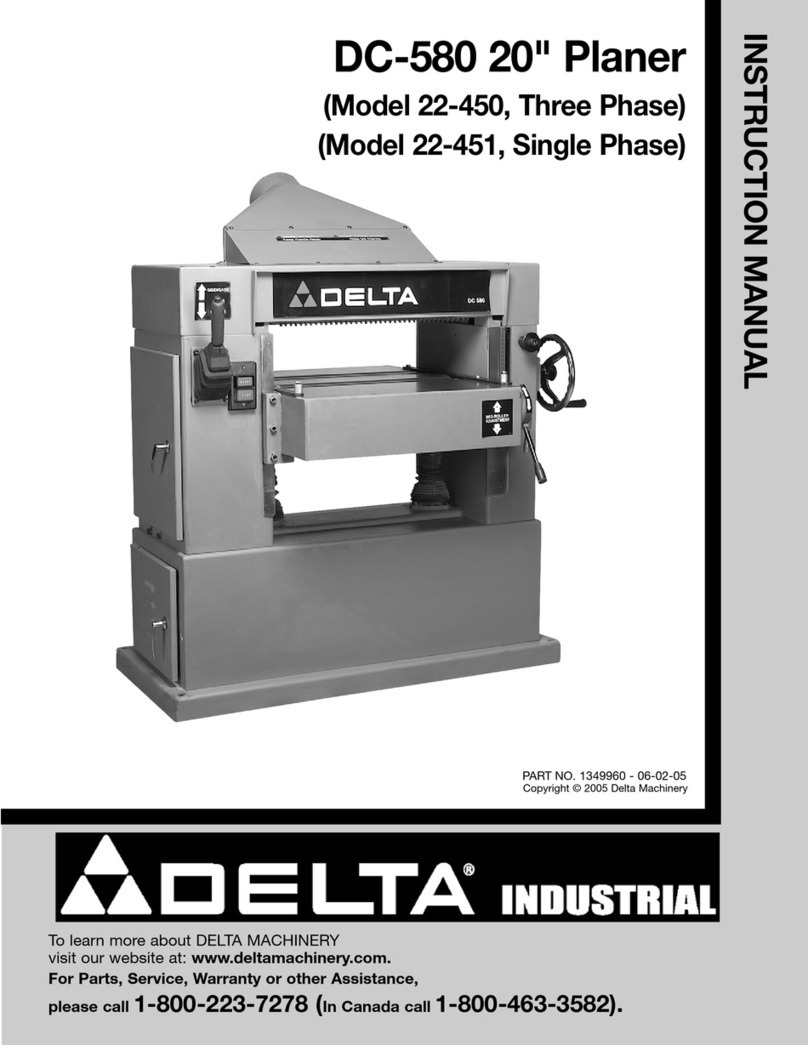
Delta
Delta DC-580 20" PLANER 22-450 User manual
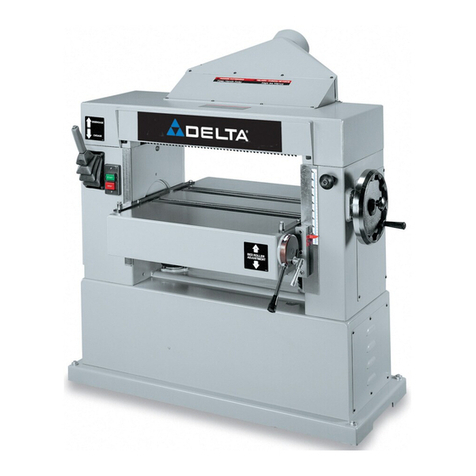
Delta
Delta 22-470 User manual
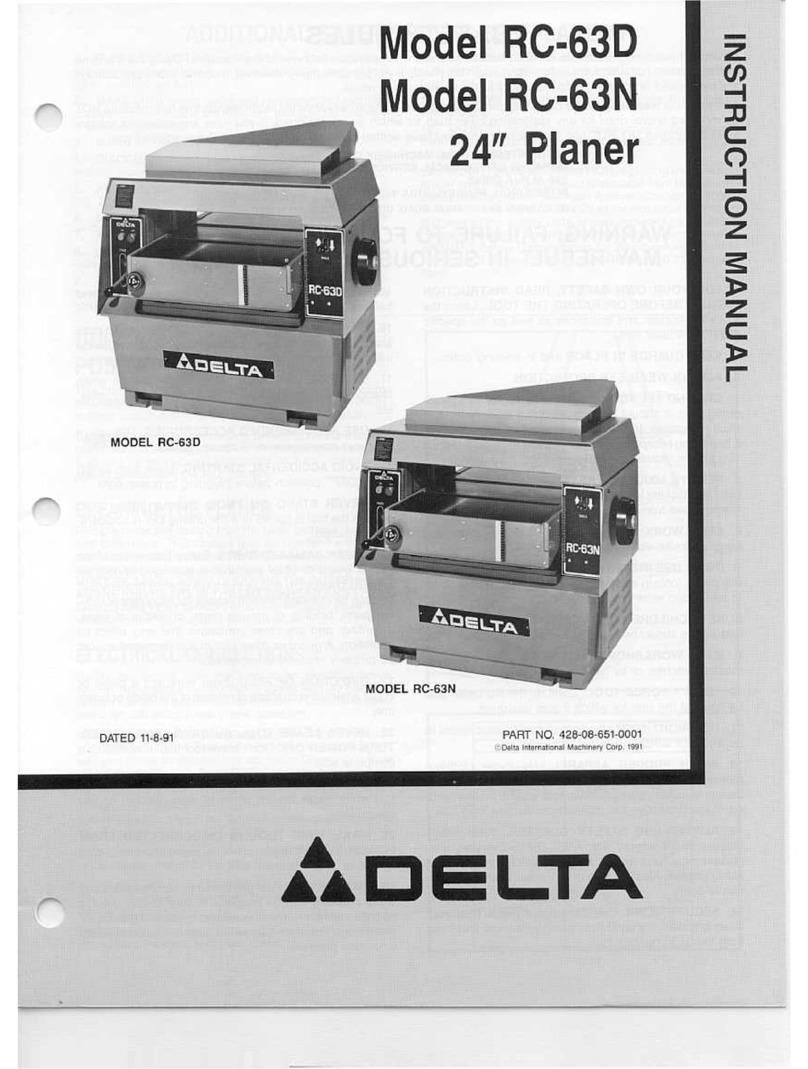
Delta
Delta RC-63D User manual
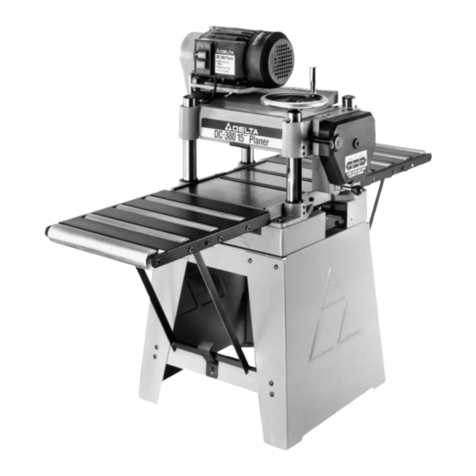
Delta
Delta 22-681 User manual
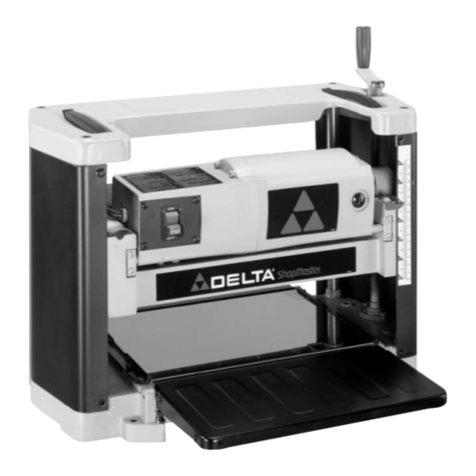
Delta
Delta ShopMaster TP300 User manual
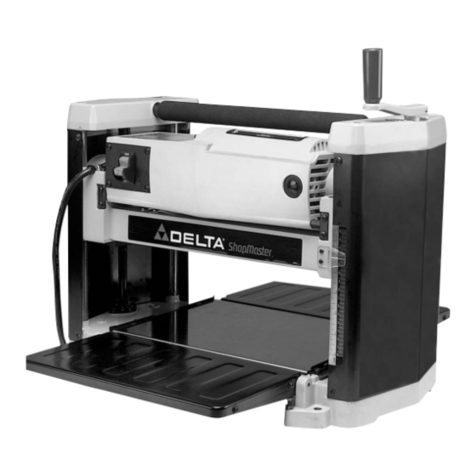
Delta
Delta TP305 User manual
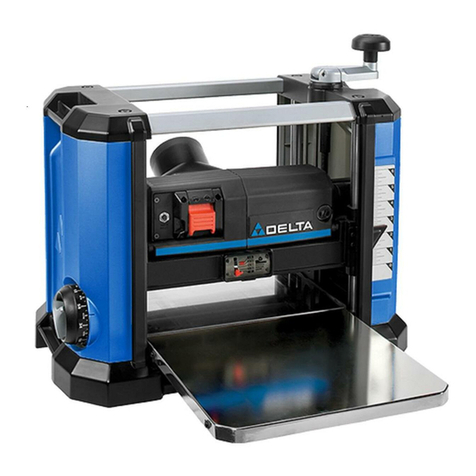
Delta
Delta 13" PORTABLE PLANER 22-590 User manual
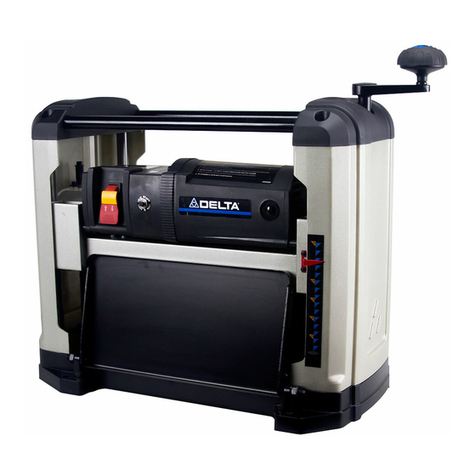
Delta
Delta 22-555 User manual

Delta
Delta TP305 User manual
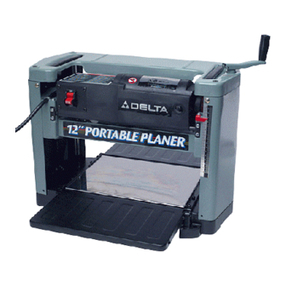
Delta
Delta 22-540 User manual

Delta
Delta RC-51 User manual

Delta
Delta 22-580 User manual
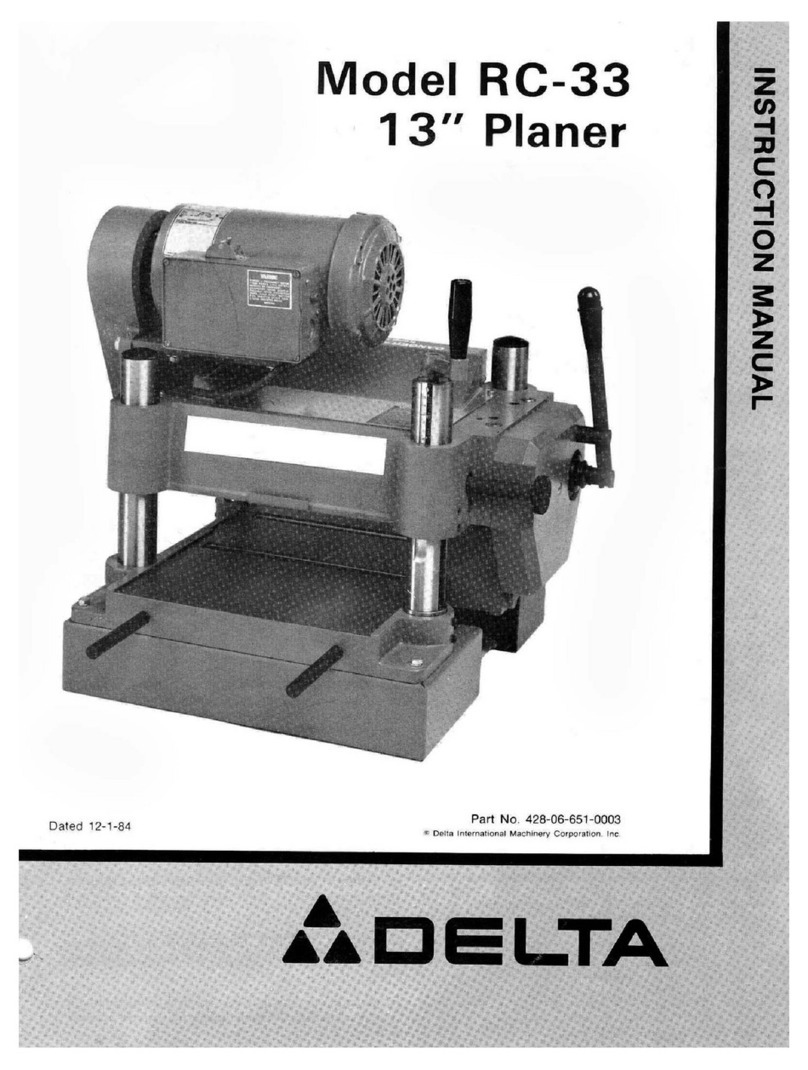
Delta
Delta RC-33 User manual

Delta
Delta 22-540 User manual

Delta
Delta TP305 User manual

Delta
Delta 22-790X User manual
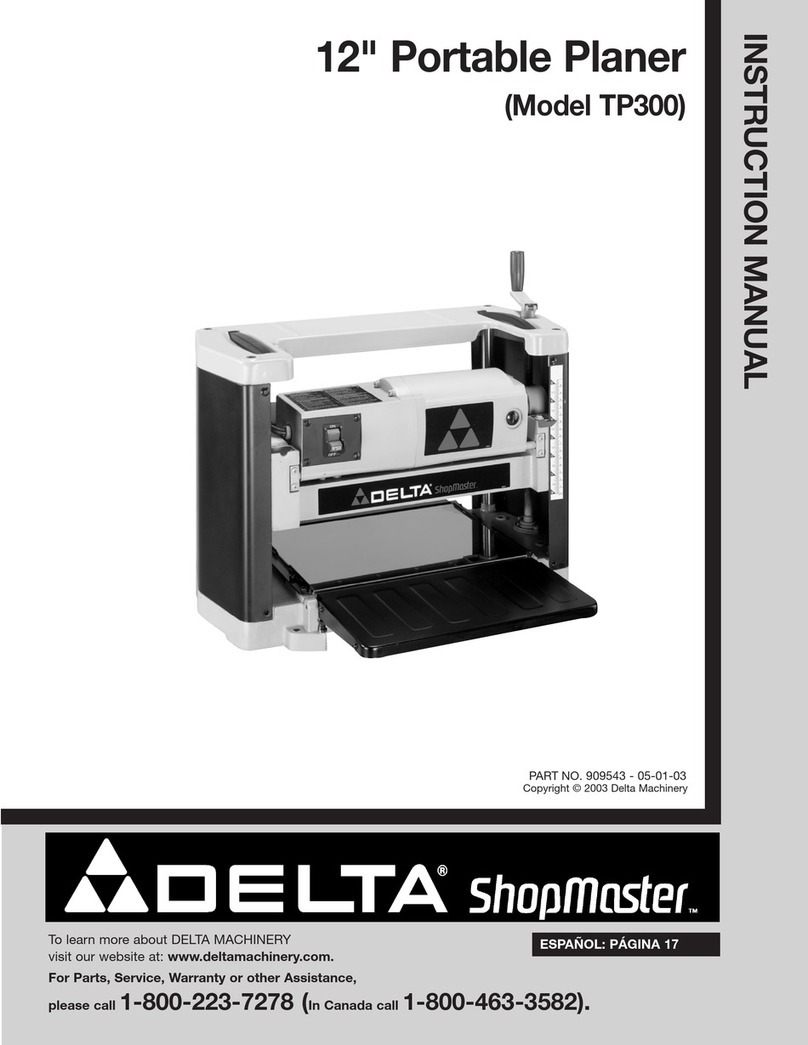
Delta
Delta ShopMaster TP300 User manual
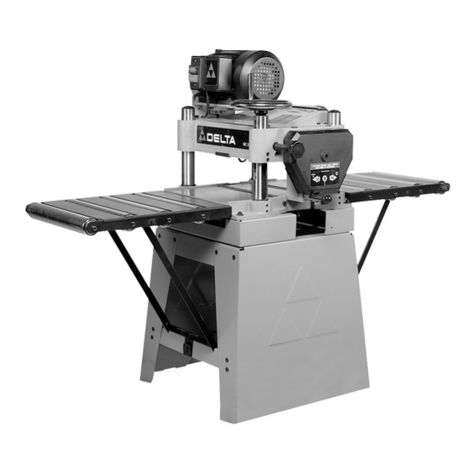
Delta
Delta 22-785 User manual
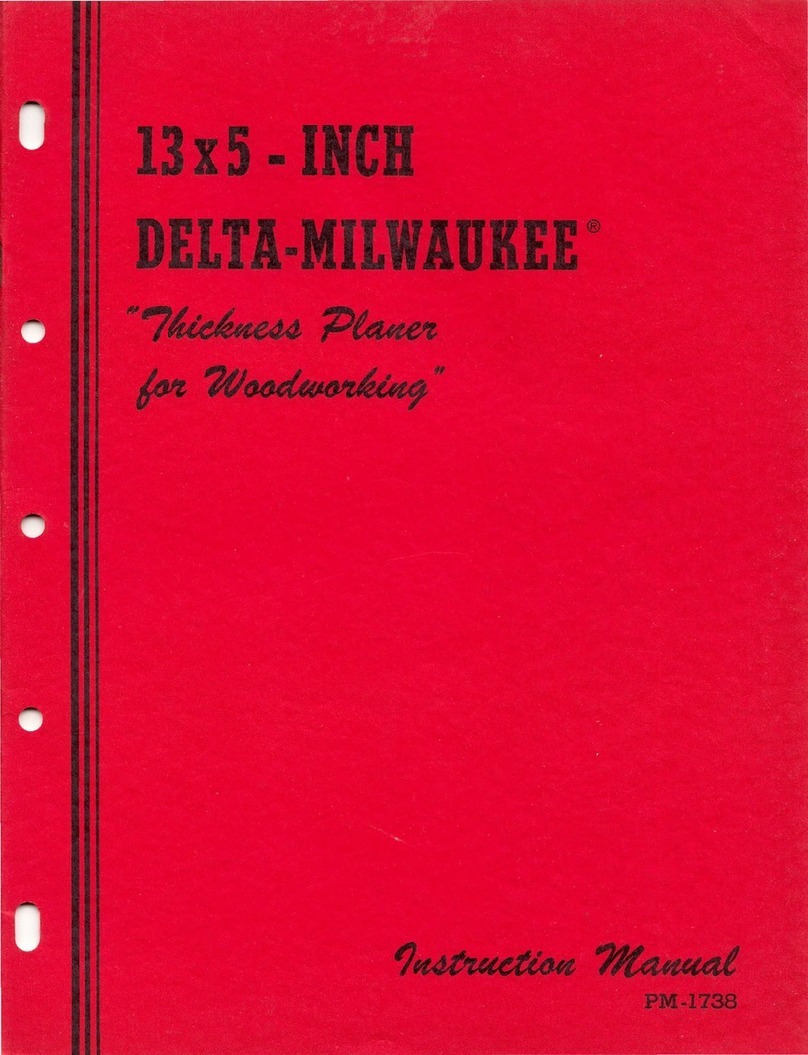
Delta
Delta Milwaukee PM-1738 Manual

Delta
Delta 22-560 User manual
